Immediate Dental Implant Placement
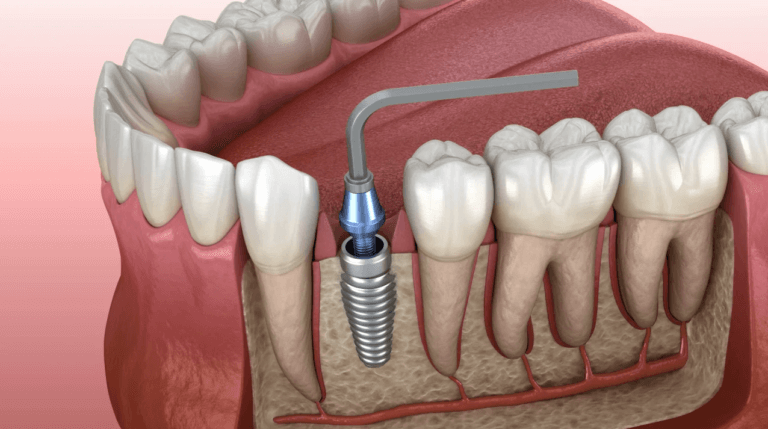
What Is Immediate Dental Implant Placement?
Immediate Dental Implant Placement is a revolutionary approach towards dental implants that offers numerous advantages for individuals seeking tooth replacement solutions after having a tooth extracted. This technique involves the placement of a dental implant immediately after the extraction of a natural tooth, streamlining the dental implant surgery process and reducing treatment times significantly.
Traditionally, dental implant procedures necessitate a multi-step process, with months of healing between tooth extraction and implant placement. For example, after removing a tooth, the dentist may elect to place a bone graft in the extraction socket, let that heal for up to 6 months, before performing a second dental implant placement surgery. However, Immediate Dental Implant Placement aims to expedite this process, providing patients with an efficient and convenient alternative all in one visit. By eliminating the waiting period between tooth extraction and implant placement, patients can have simultaneous implant placement at the time of tooth removal, significantly reducing the overall treatment time by as much as 6 months.
Before deciding on whether Immediate Dental Implant Placement are right for you, there are some things you should know:
- Am I A Candidate For Immediate Dental Implant Placement?
- What Are The Contraindications For Immediate Dental Implant Placement?
- What Are The Alternative Treatments If I Do Not Choose Immediate Dental Implant Placement?
- How Much Does Immediate Dental Implant Placement Cost?
- What Are The Steps In The Immediate Dental Implant Placement Procedure?
- What Are Common Problems With Immediate Dental Implant Placement?
If you have any further questions about Immediate Dental Implant Placement or other dental services offered at Atlas Dental, please contact us.

Free phone consultation
Have questions about immediate dental implant placement? Schedule a free phone consultation with our Toronto dentist.

5 star google reviews
Our patients love us! See for yourself why people are choosing Atlas Dental in Toronto for immediate dental implant placement.

Dental Implant Emergency service
Broke a tooth and need a dental implant? Book an emergency appointment today.
Am I A Candidate For Immediate Dental Implant Placement?
Immediate Dental Implant Placement is a highly specialized dental procedure that offers numerous advantages, but it is not suitable for every situation. Dentists carefully assess each case to determine if immediate implant placement is the right choice. Here are the key indications and scenarios where this approach is typically recommended:
- Missing Single Tooth: Immediate Dental Implant Placement is commonly used to replace a single missing tooth. Whether the tooth was lost due to trauma, decay, or other reasons, this technique provides a swift and effective solution.
- Healthy Gum and Bone Tissue: Candidates should have healthy gum and bone tissue in the area of the missing tooth. A sufficient bone volume and quality are essential to ensure the implant’s stability and long-term success.
- Preservation of Aesthetic Zone: When a missing tooth is located in the aesthetic zone, which includes the front teeth that are highly visible when you smile, immediate implant placement is often preferred. It ensures a more natural-looking and rapid restoration of your smile.
- Preventing Bone Loss: Immediate Dental Implant Placement helps prevent the rapid loss of jawbone density that occurs after tooth extraction. By placing the implant immediately, it stimulates the surrounding bone, preserving its volume and structure.
- Convenience and Efficiency: Patients seeking a quicker and more streamlined dental implant process may opt for immediate placement. It reduces the overall treatment time compared to traditional implant procedures, as there is no need to wait for the extraction site to heal before implant placement.
- Avoiding Removable Dentures: Immediate implant placement can be a preferred option for patients who want to avoid the use of removable dentures. It provides a fixed and stable solution for tooth replacement.
- Restoring Oral Function: Whether it’s for chewing, speaking, or overall oral function, immediate implant placement allows patients to regain these functions more rapidly compared to delayed implant procedures.
- Patients in Good Health: Candidates should generally be in good overall health to undergo dental implant surgery. Your dentist will assess your medical history and evaluate your suitability for this procedure.
It’s important to note that not all cases are ideal for Immediate Dental Implant Placement. Your dentist will conduct a thorough examination, which may include X-rays and 3D imaging, to determine the best treatment plan for your specific needs. In some situations, delayed implant placement or additional procedures may be recommended to ensure the success of your dental implant. If you have further questions about Immediate Dental Implant Placement, please contact us.
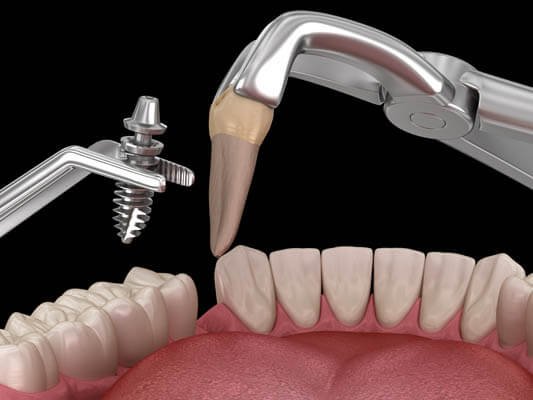
What Are The Contraindications For Immediate Dental Implant Placement?
While Immediate Dental Implant Placement offers numerous advantages, it is not suitable for all patients and dental situations. Dentists carefully assess each case to determine whether immediate implant placement is the right choice. Here are some common contraindications, situations where this approach may not be recommended:
- Insufficient Bone Density: Adequate bone volume and quality are crucial for the success of dental implants. If a patient lacks the necessary bone density in the area where the implant is required, immediate placement may not be feasible. In such cases, bone grafting or augmentation procedures may be necessary before implant placement.
- Active Infection or Gum Disease: Patients with active oral infections or advanced gum disease may not be suitable candidates for immediate implant placement. These conditions can compromise the success of the implant and its integration with the surrounding tissues.
- Uncontrolled Systemic Health Conditions: Individuals with uncontrolled systemic health conditions, such as unmanaged diabetes or autoimmune disorders, may not be considered ideal candidates for immediate implant placement. It is essential for patients to have good overall health to support the healing and integration of dental implants.
- Heavy Smoking or Tobacco Use: Smoking and tobacco use can significantly hinder the healing process and increase the risk of implant failure. Dentists may advise patients to quit smoking or reduce their tobacco use before considering immediate implant placement.
- Pregnancy: Pregnant women are generally not recommended for elective dental procedures, including implant placement, due to potential risks and considerations related to anesthesia and medication use during pregnancy.
- Complex Anatomical Structures: In some cases, the presence of complex anatomical structures, such as nerves or sinuses, near the implant site may make immediate implant placement more challenging or risky. Careful assessment and planning are essential to avoid complications.
- Inadequate Soft Tissue Support: Adequate soft tissue (gum) support around the implant site is essential for proper healing and implant stability. If there is insufficient soft tissue coverage or if the implant may be exposed to excessive stress, immediate placement may not be recommended.
- Patient Preferences and Expectations: Some patients may have specific preferences or expectations regarding their treatment timeline. If a patient is not comfortable with immediate implant placement or prefers a different approach, their wishes and comfort should be considered in the treatment plan.
It’s important to understand that the decision regarding immediate implant placement is made on a case-by-case basis after a thorough evaluation by a qualified dentist or oral surgeon. In cases where immediate placement is contraindicated, alternative treatment options, such as delayed implant placement or other restorative solutions, will be discussed with the patient to ensure the best possible outcome for their dental health. If you have further questions about Immediate Dental Implant Placement, please contact us.
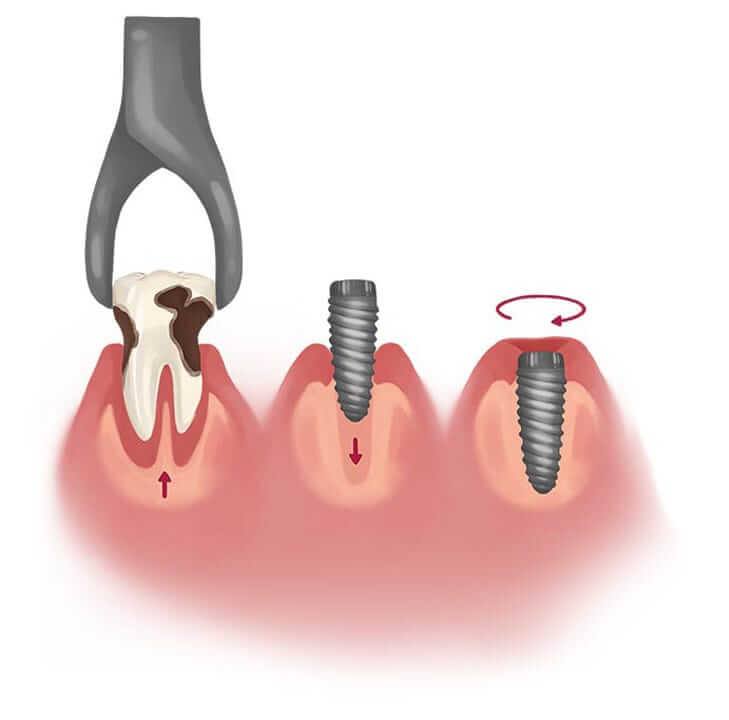
What Are The Alternative Treatments If I Do Not Choose Immediate Dental Implant Placement?
While Immediate Dental Implant Placement offers a rapid and effective solution for tooth replacement, it may not be the best option for everyone. Several alternative treatments are available for individuals who choose not to undergo immediate implant placement or who are not suitable candidates for this procedure. Here are some common alternative treatments:
- Delayed Implant Placement: In cases where immediate implant placement is contraindicated due to inadequate bone density or other factors, delayed implant placement may be recommended. This approach involves allowing the extraction site to heal for a period of time before the implant is placed. During this healing phase, bone regeneration may occur, improving the conditions for implant placement.
- Bone Grafting and Augmentation: When a patient has insufficient bone volume or density to support an implant, bone grafting or augmentation procedures may be necessary. These techniques involve adding bone graft material to the deficient area to create a stable foundation for the implant. After the graft has integrated with the existing bone, the implant can be placed.
- Fixed Dental Bridges: A fixed dental bridge is a traditional restoration method for replacing missing teeth. It involves anchoring an artificial tooth (pontic) between two adjacent healthy teeth (abutments) using crowns. This option is suitable when the neighboring teeth are strong and in good condition.
- Removable Partial Dentures: Removable partial dentures are removable appliances that replace one or more missing teeth. They are secured using clasps or other attachments to adjacent teeth and can be taken out for cleaning. This option is more affordable but may not provide the same stability as implants.
- Complete Dentures: Complete dentures are used when a patient has lost all of their natural teeth. They are removable appliances that rest on the gums and are held in place by suction or adhesive. While complete dentures restore the appearance of a full set of teeth, they can be less stable and functional than implants.
- Resin-Bonded Bridges: Also known as Maryland bridges, these are conservative alternatives to traditional fixed bridges. They are bonded to the back of adjacent teeth using metal or resin wings and are suitable for replacing a single missing tooth.
- Orthodontic Treatment: In some cases, orthodontic treatment may be recommended to close the space created by a missing tooth. Once the gap is closed, alternative restorative options, such as a dental bridge, can be considered.
- Observation: In situations where a patient chooses not to pursue immediate implant placement or any of the alternative treatments, they may opt to leave the gap empty to heal on its own and closely monitor their oral health. However, this approach may lead to further dental issues, such as shifting of adjacent teeth and bone loss over time.
The choice of an alternative treatment depends on various factors, including the patient’s oral health, preferences, budget, and the recommendations of their dentist. It’s essential to have a thorough discussion with a qualified dental professional to determine the most suitable treatment option based on your individual circumstances and goals for oral health and aesthetics. If you have further questions about Immediate Dental Implant Placement, please contact us.
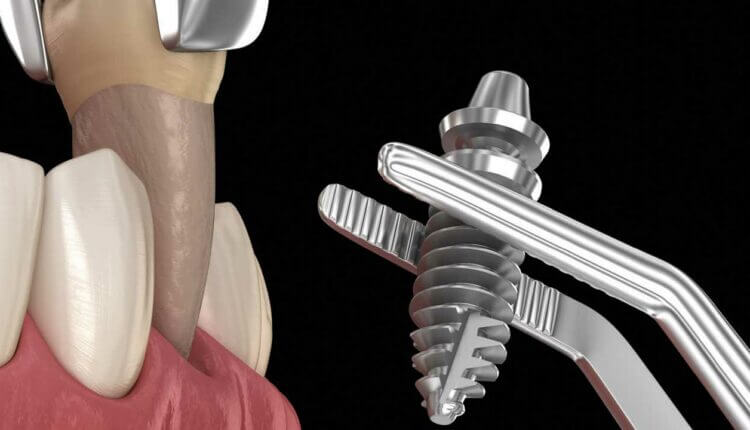
Cost of Dental Implant
A Dental Implant often involves multiple components and fees including tooth removal (code 71201), the dental implant placement (79931), bone grafting (72421) and the dental implant crown (27215). Therefore, depending on your needs, the cost of a single tooth dental implant can range between $4165 to $5222. The codes relevant to dental implants in the Ontario Dental Association’s Suggested Fee Guide appear as follows:
Removals, Erupted Teeth, Complicated
- 71201 – Removals, Erupted Tooth, Surgical Approach, Requiring Surgical Flap and/or Sectioning of Tooth: $307
Implants, Osseointegrated, Root Form, More than one component
- 79931 – Surgical Installation of Implant with Cover Screw – per implant: $1785+ Dental Materials Expense (approximately $350)
Alveolar Bone Preservation – Allograft
- 72421 – First tooth: $450 + Dental Materials Expense (approximately $300)
Crowns, Porcelain/Ceramic/Polymer Glass Fused to Metal
- 27215 – Crown, Porcelain/Ceramic/Polymer Glass Fused to Metal Base, Implant-Supported: $1280 + Dental Lab Fee + Dental Materials Expense (approximately $750)
In Ontario, most dentists will provide basic dental surgery and restorative dental services consistent with the Ontario Dental Association’s Suggested Fee Guide, such as dental emergency examinations, dental x-rays and tooth extractions, to ensure fair and competitive treatment cost. The Ontario Dental Association’s Suggested Fee Guide is a proposed fee structure that dentists in Ontario may or may not follow. Please consult with your dentist about fees before going ahead with treatment.
Each dental implant surgery case is unique. Depending on your unique circumstance, implant surgery may be more difficult and more expensive if any of the following is required:
- CBCT scanning
- Computer guided implant surgery
- Immediate implant placement following tooth extraction
- Bone grafting to prevent bone loss
- Bone regeneration to grow new bone
- Simultaneous gum graft procedures
- Immediate tooth replacement at the time of surgery
- Sinus lifting procedures to raise the maxillary sinus floor
Dental Implant services are usually considered a supplementary service by dental insurance plans and may or may not be covered by your dental insurance. Be sure to find out from your dental insurance plan provider how much you are eligible for before going ahead with dental treatment. Your dentist can help you submit an predetermination to your dental insurance.
For patients without dental insurance, Atlas Dental is pleased to offer dental financing through Dentalcard. Affordable payment plans start at 7.95% for terms of 6 months to 6 years. To learn more about Dentalcard dental treatment financing, follow this link.
What Are The Steps In The Immediate Dental Implant Placement Procedure?
The Immediate Dental Implant Placement procedure comprises several crucial stages, each meticulously orchestrated to ensure the efficient replacement of a missing tooth. Let’s delve into the comprehensive breakdown of these essential steps:
- Initial Consultation: The journey commences with an in-depth initial consultation with your dentist or oral surgeon. During this crucial appointment, your oral health will be comprehensively assessed, encompassing a thorough examination of your medical history, dental condition, and your specific treatment objectives. This stage often involves the use of advanced dental imaging techniques, such as digital X-ray images and 3D CBCT scans, to gain precise insights into the state of your jawbone and to determine the feasibility of immediate implant placement.
- Treatment Planning: With a wealth of diagnostic information at their disposal, your dental practitioner will embark on crafting a tailored treatment plan meticulously customized to your unique needs and circumstances. This detailed plan serves as a roadmap for the entire procedure and explicitly outlines the number of dental implants required, their precise locations, and the type of prosthetic restoration (such as crowns or bridges) to be affixed upon completion.
- Anesthesia or Sedation: On the day of the procedure, the paramount concern is your comfort and well-being. To this end, local anesthesia will be skillfully administered to ensure that the treatment area remains completely numb throughout the procedure. Depending on your individual preferences and the complexity of the case, you may also be offered various sedation options such as moderate conscious sedation to guarantee your utmost ease and relaxation during the implant placement process.
- Tooth Extraction: In scenarios where the natural tooth is still in the bone,the dentist will skillfully and painlessly remove it.
- Immediate Implant Placement: After removing the natural tooth, the dentist will assess the extraction socket to see if there is sufficient bone remaining to support a dental implant. This pivotal step involves a series of meticulously executed surgical techniques, including meticulous preparation of the implant site with a series of drills, and the careful insertion of the implant into the jawbone. These dental implants, often crafted from biocompatible materials like titanium or zirconia, serve as artificial tooth roots, ensuring they seamlessly integrate with the surrounding bone over time. If there is insufficient bone to support a dental implant, the dentist may choose to put a bone graft instead.
- Dental Bone Graft Placement: In the empty areas of the extraction socket not occupied by the dental implant, the dentist will pack this space with dental bone grafting material to ensure adequate healing of the bone surrounding the implant. A collagen membrane may be placed over top of the bone graft and dental implant.
- Suturing and Healing: Following the successful implant and bone graft placement, meticulous suturing of the gum tissue is performed to facilitate proper healing and safeguard the surgical site against external factors.
- Temporary Restoration (if applicable): In certain cases, especially the visible anterior teeth region where a missing tooth may be noticeable, a temporary dental implant crown or removable partial denture may be expertly attached to the implant right after its placement. This temporary solution ensures that you can maintain your normal oral function and aesthetic appearance during the initial healing phase.
- Healing Period: Over the subsequent few months, a critical phase known as osseointegration begins. The implant gradually and securely fuses with the surrounding bone tissue, establishing a rock-solid foundation for the future dental implant crown
- Final Restoration: Once the osseointegration process is deemed successfully completed, and the implant is unequivocally integrated with the jawbone, the time arrives for the attachment of a permanent dental implant crown. The implant crown is skillfully crafted to match your natural teeth in color, shape, and functionality, ensuring that you enjoy a fully functional and aesthetically pleasing result.
- Ongoing Maintenance: After delivery of your dental implant crown, your dentist will provide you with post-insertion instructions. Maintaining the health of the dental implant crown is important for the enduring success of your dental implant.
Familiarizing yourself with these comprehensive stages of the Immediate Dental Implant Placement procedure can alleviate any uncertainties and empower you to make informed decisions concerning your dental health. If you have further questions about Immediate Dental Implant Placement, please contact us.
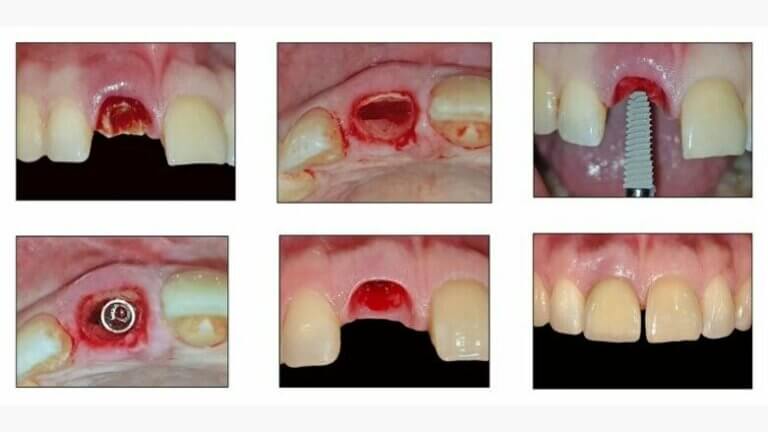
What Are Common Problems With Immediate Dental Implant Placement?
While Immediate Dental Implant Placement is a well-established and effective procedure, like any surgical intervention, it carries potential risks and complications. It’s essential to be aware of these common issues and challenges associated with the procedure:
- Dental Infection: Infection can occur at the implant site or in the surrounding tissues. It is essential to maintain proper oral hygiene and follow post-operative care instructions to minimize the risk of infection. Prompt treatment is necessary if infection does occur.
- Peri-Implantitis: This condition involves inflammation and infection of the soft and hard tissues surrounding the implant. It can lead to implant failure if not treated promptly and effectively.
- Implant Failure: While dental implants are designed to be durable and long-lasting, there is a risk of implant failure. This can happen if the implant does not properly integrate with the surrounding bone (osseointegration). Factors such as poor bone quality, infection, or excessive forces on the implant can contribute to implant failure.
- Gum Recession: In some cases, gum recession may occur around the implant, exposing the implant’s metal or creating an unaesthetic appearance. Gum recession can be addressed through various techniques, such as gum grafting.
- Nerve or Tissue Damage: During the implant placement procedure, there is a slight risk of damaging adjacent nerves or tissues. This can result in numbness, tingling, or altered sensation in the surrounding areas. These complications are relatively rare but should be reported to your dentist immediately if experienced.
- Bone Resorption: Over time, the jawbone may naturally undergo some resorption (bone loss). This can affect the long-term stability of the implant and may require bone grafting or other treatments to address.
- Prosthetic Complications: Issues related to the prosthetic restoration, such as a loose dental implant crown, chipping, or wear, can occur over time. Regular dental check-ups can help detect and address these problems early.
It’s important to note that while these complications can occur, they are relatively infrequent, and the majority of immediate dental implant placements are successful. Careful patient selection, proper surgical technique, and post-operative care are essential in minimizing the risks associated with this procedure. Before undergoing Immediate Dental Implant Placement, it’s crucial to have a thorough discussion with your dental provider to understand the potential risks and benefits. If you have further questions about Immediate Dental Implant Placement, please contact us.
We also think you’ll like…
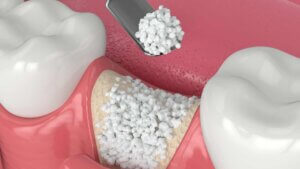
Dental Bone Graft
Dental Bone Graft What Is Dental Bone Graft? Dental bone grafting is a remarkable procedure designed to restore and enhance the underlying bone structure of
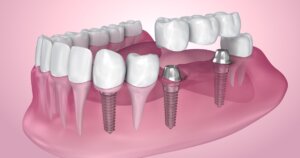
Dental Implant Crown
Dental Implant Crown What Is A Dental Implant Crown? A Dental Implant Crown is a crucial component of a dental implant, which is a permanent
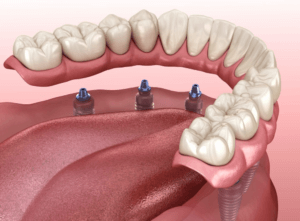
Implant Denture
Implant Denture What Is An Implant Denture? An Implant Denture, also known as an implant-supported overdenture, is a dental appliance designed to restore missing teeth
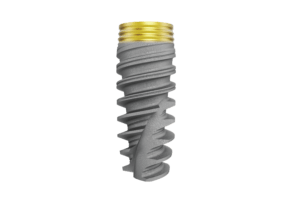
Nobel Dental Implants
Nobel Dental Implants What Are Nobel Dental Implants? Nobel Biocare is a renowned and globally recognized dental implant company that has played a pivotal role

Tooth Trauma
Tooth Trauma What Is Tooth Trauma? Tooth trauma refers to any injury that affects the teeth or surrounding structures, such as the gums, lips, or
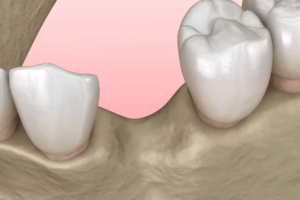
Dental Bone Loss
Dental Bone Loss What Is Dental Bone Loss? Dental bone loss, also known as periodontal bone loss or alveolar bone loss, refers to the loss

